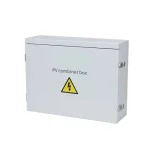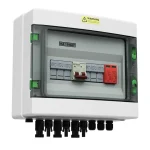As solar energy adoption continues to grow across residential, commercial, and utility-scale projects, system design becomes increasingly important. While solar panels are the most visible component, many people overlook a critical element of a solar power system: the PV combiner box.
This often-underestimated device plays a major role in ensuring safety, simplifying wiring, and enabling maintenance. If you’re building or managing a solar project, understanding the PV combiner box is essential for long-term performance and reliability.
What Is a PV Combiner Box?
A PV combiner box, also known as a solar combiner box or DC combiner box, is an electrical enclosure that consolidates the output from multiple photovoltaic (PV) strings into a single DC output.
It usually sits between the solar panels and the inverter. By merging several inputs into one output, the box simplifies wiring, reduces cable runs, and protects the system from electrical faults.
Basic Functions:
Combining DC inputs: Connects multiple solar panel strings (e.g., 4, 6, 8 or more) into a single output
Circuit protection: Includes fuses, circuit breakers, or both, to prevent damage from overcurrent
Surge protection: Built-in SPD (Surge Protection Device) safeguards against lightning or power surges
Monitoring (optional): Smart models may offer current/voltage measurement and fault alerts
Why Is a PV Combiner Box Essential?
You might wonder: Can’t we connect solar panels directly to the inverter? Technically yes, but it’s inefficient, risky, and hard to manage. Here’s why a combiner box is indispensable:
1. Improved System Safety
Each string of solar panels carries high DC voltage. If a string develops a fault, it can damage the inverter or even cause fire. A PV combiner box isolates and protects each string individually with fuses or breakers, greatly reducing system-wide risks.
2. Simplified Installation and Maintenance
Without a combiner box, you’d need to run separate cables from every panel string to the inverter. That’s expensive and messy. A combiner box reduces cable runs, making the layout clean and more serviceable. In case of faults, technicians can identify and isolate the problem string quickly.
3. Better Surge Protection
Lightning strikes or grid-related voltage surges can destroy sensitive solar electronics. High-quality combiner boxes (like those from Derlicn Electric) include DC surge protection modules to absorb such spikes, increasing overall system lifespan.
4. Optional Monitoring Features
Some combiner boxes include built-in monitoring systems for voltage, current, temperature, and alarms. This feature is valuable for large-scale or remote installations, enabling real-time system diagnostics and performance optimization.
Where Is a PV Combiner Box Installed?
A PV combiner box is typically mounted outdoors, near the solar array. It must meet specific standards for weatherproofing and UV resistance, often built with IP65 or higher-rated enclosures. This ensures reliable operation even under harsh environmental conditions.
How to Choose the Right PV Combiner Box
When selecting a combiner box for your solar project, consider the following factors:
Number of inputs (strings): Choose based on your array size—common options include 4-in-1-out, 6-in-1-out, etc.
Voltage and current rating: Match with your solar panel specs (typically 600V/1000V/1500V DC)
Protection devices: Ensure it includes fuses or breakers and surge protection
IP rating: Outdoor installations should use IP65 or higher
Smart functions: For large projects, choose boxes with remote monitoring, Modbus communication, or fault alarms
Two Main Types of Enclosures: Metal vs. Plastic
PV combiner boxes are generally available in two main enclosure materials—metal and plastic—each offering different advantages depending on the installation environment:
Metal Enclosure (Iron or Steel):
These combiner boxes are often made from powder-coated iron or stainless steel. They are highly durable, flame-retardant, and offer excellent mechanical strength and electromagnetic shielding, making them ideal for industrial, commercial, or outdoor installations in harsh conditions. However, they are heavier and may be more prone to corrosion if not properly treated.Plastic Enclosure (Polycarbonate or ABS):
Lightweight and corrosion-resistant, plastic (typically polycarbonate) enclosures are easier to install and transport. They provide sufficient protection in non-extreme environments such as residential rooftops or indoor utility rooms. While they generally offer lower mechanical strength, they are often more cost-effective and UV-resistant.

Metal Shell PV Combiner Box

Plastic Shell PV Combiner Box
Choosing between the two depends on your application scenario, local climate, safety standards, and budget. High-quality PV combiner boxes—regardless of shell material—should comply with IP65 or higher waterproof and dustproof ratings to ensure long-term reliability in solar power systems.
Applications of PV Combiner Boxes
PV combiner boxes are used across a wide range of installations:
Residential rooftop solar
Commercial and industrial solar systems
Utility-scale solar farms
Off-grid power stations
Telecom or transportation solar systems
Each application benefits from reduced complexity, improved safety, and enhanced monitoring capability.
Derlicn Electric: Reliable Combiner Boxes for Your Solar Needs
At Derlicn Electric, we manufacture robust, customizable PV combiner boxes tailored to your project’s size and safety requirements. Our products meet global electrical standards and are built for long-term outdoor performance. Whether you need a simple 4-input combiner or a smart monitoring solution for a utility-scale solar farm, we have the right solution for you.
We also provide technical support, datasheets, and wiring diagrams to help ensure proper installation and operation.
Conclusion
A PV combiner box might seem like a small part of your solar installation, but it has a big impact on safety, performance, and scalability. By consolidating wiring, enhancing protection, and enabling easy maintenance, it ensures your system runs smoothly and efficiently for years to come.
If you’re planning a new solar project or upgrading an existing one, make sure you choose the right PV combiner box—and the right supplier.
👉 Need help choosing the right combiner box? Contact Derlicn Electric today to get expert advice and custom solutions.
Table of Contents
Have you Any Questions?
Can’t find an answer to your question, or want more information about our products? If so, please feel free to get in touch with our professional team. We’re here to help you drive your projects to success.
